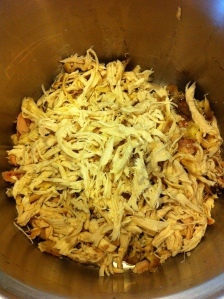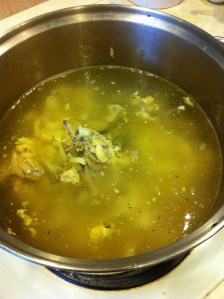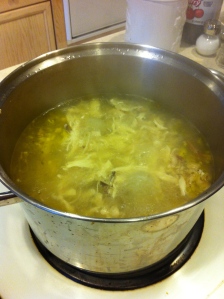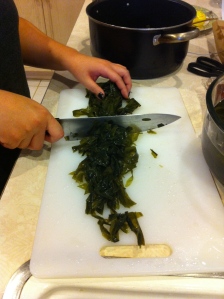Korean Seaweed Soup: Chicken Miyukguk is a nutritious, healing soup recipe that is perfectly comforting on a cold night.

Traditionally, most Korean girls eat miyukguk after they have a baby. This hearty seaweed soup is not only extremely nutritious, but for women who just gave birth, this soup supposedly helps with your milk production.
After the birth of my first daughter, my mom made me bowls and bowls of this stuff – and I ate it all! Personally, it did not help me in the milk production area… but I just LOVE seaweed soup. And now I happily make this soup for my daughters, who also love it!
Because of its healing properties, we also tend to eat/serve this seaweed soup more when people are sick or not feeling well.
Did you know: “Seaweeds are among the healthiest foods on the planet, packed with vitamins, minerals, and antioxidants. And recently Oprah tell us that seaweed is great for the waistline too! A 2010 study found the algae can reduce our rate of fat absorption by 75%, thanks to its inhibitory effect on a digestive enzyme called lipase.” Read more here.
HOW TO MAKE Korean Seaweed Soup: Chicken Miyukguk
You can make this seaweed soup stock using beef, chicken, or with seafood – some people like to make this soup with mussels.
The soup recipe below is easy and uses an already cooked rotisserie chicken. Using a precooked rotisserie chicken (first removing the skin) will create tasty a soup with less fat. Plus, the soup cooks in less time because the chicken is already cooked!
Because this seaweed soup is meant to be an ultimate comfort dish, you certainly want to make sure you love all of the ingredients and their ratios. As you make this soup more and more, you’ll know how much of each ingredient to put in to your liking!
WHAT YOU’LL NEED TO MAKE CHICKEN MIYUKGUK
- 1 (1 ounce) package dried seaweed (can be purchased at any Asian/Korean grocery store or market; pictured below)
- 1 precooked rotisserie chicken
- 1-2 tablespoons soy sauce (to taste + more if needed later); try to buy the soy sauce that is meant for soups. It’s pictured below. If you can’t find it, regular low sodium soy sauce is fine.
- 1 teaspoon salt, or to taste
- Water – enough to cover the chicken and then a little more
- 1-2 teaspoons minced garlic
- 1 medium onion (optional)
HOW TO MAKE KOREAN SEAWEED SOUP
1. Soak seaweed in water (enough water to cover the seaweed) for at least 30 minutes. The longer you can soak the seaweed the better. I have soaked it for up to an hour beforehand. Soaking the seaweed loosens and softens it because you buy it dry.
2. While you are soaking the seaweed, de-bone your rotisserie chicken, making the pieces as big or small as you want. Remove the skin and keep the bones (except the gizzard part) and add those into the pot. The bones will help create a nice chicken stock flavor.
3. Once you’ve got all the chicken (and bones) in a big pot, cover all of the ingredients with water. Place on the stove and bring to a boil. The longer you boil your chicken, the better. This is actually creating the soup. You can remove any fat that rises to the top but there should not be much at all. Boil the chicken for at least 30 minutes before you then add the seaweed after completing step #4 below.
5. Then stir in the cut up seaweed into the chicken soup, and add 1 tablespoon of soy sauce; cook for 1 minute. Pour in 2 cups of water, and bring to a boil. (Feel free to add more water if you think you need it). Stir in garlic, bring to a boil again, cover, and reduce heat. Simmer for at least 20 minutes. Season with salt and more soy sauce if needed.
That’s it! Chicken miyukguk is so incredibly easy to make that everyone will be feeling good as new in no time.

Beef Miyukguk
If you want to make this soup with beef, you will need 1/4 pound (or 1/2 pound depending on how much meat you want) of top sirloin beef, minced.
Do this after you have soaked the seaweed: Heat a saucepan over medium heat; add beef, sesame oil, 1/2 tablespoon soy sauce, and a little salt, and cook for 1 minute. Stir in seaweed and remaining 1 tablespoon soy sauce; cook for 1 minute, stirring frequently. Pour in 2 cups water, and bring to a boil. (Feel free to add more water if you think you need it). Stir in garlic, bring to a boil again, cover, and reduce heat. Simmer for at least 20 minutes. Season with salt and more soy sauce.
I hope you and your family enjoy this Korean seaweed soup!
LOOKING FOR MORE SATISFYING SOUP RECIPES?
- Pressure Cooker Beef Pho
- Homemade Chicken Noodle Soup
- Chinese Egg Drop Soup
- Jjamppong: Spicy Seafood Soup
- Korean Oxtail Soup (Kkori Gomtang)
- Instant Pot Chicken Posole
- Healthier, Less Loaded Potato Soup
Korean Seaweed Soup: Chicken Miyukguk
Ingredients
- 1 1 ounce package dried seaweed - can be purchased at any Asian/Korean grocery store or market
- 1 precooked rotisserie chicken
- 1-2 tbsp soy sauce - or more to taste
- 1 tsp salt
- water - you'll need enough to cover ingredients
- 1-2 tsp minced garlic
- 1 onion - optional
Instructions
- Soak seaweed in water (enough water to cover the seaweed) for at least 30 minutes. The longer you can soak the seaweed the better. *
- While you are soaking the seaweed, de-bone your rotisserie chicken, making the pieces as big or small as you want. Remove the skin and keep the bones (except the gizzard part) and add those into the pot. The bones will help create a nice chicken stock flavor.
- Once you’ve got all the chicken (and bones) in a big pot, cover all of the ingredients with water. Place on the stove and bring to a boil. The longer you boil your chicken, the better. Boil the chicken for at least 30 minutes before you then add the seaweed after completing the next step!
- When the seaweed is soft, (or after at least 30 minutes) rinse, drain, and cut into 2 inch pieces.
- Then stir in the cut up seaweed into the chicken soup, and add 1 tablespoon of soy sauce; cook for 1 minute. Pour in 2 cups of water, and bring to a boil. (Feel free to add more water if you think you need it). Stir in garlic, bring to a boil again, cover, and reduce heat. Simmer for at least 20 minutes. Season with salt and more soy sauce if needed.
Notes
Give this recipe a try, and leave a comment to let me know what you think!
Follow Hip Foodie Mom on Facebook, Instagram, and on Pinterest!
















